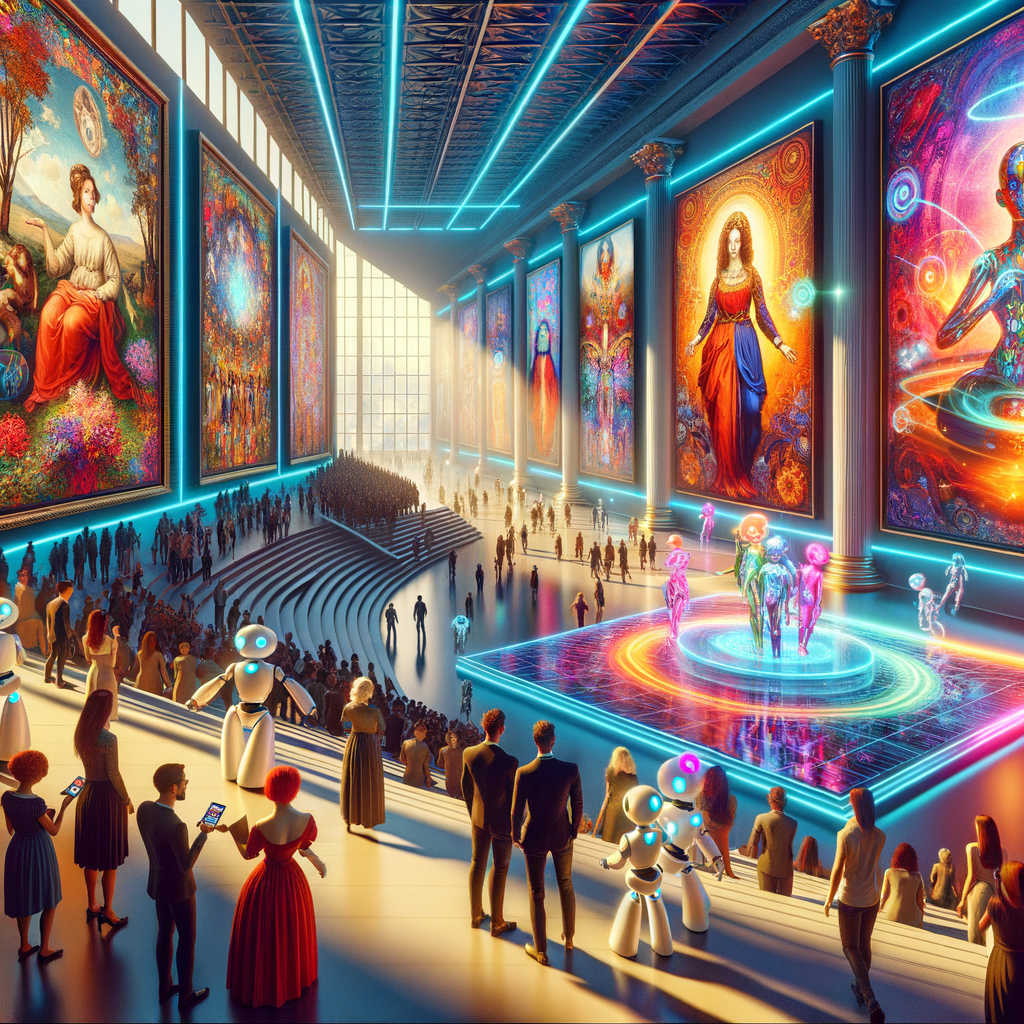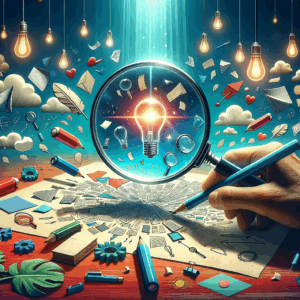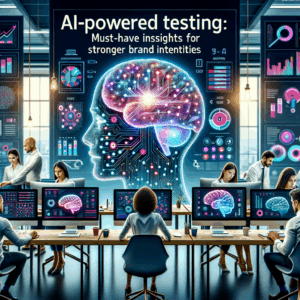
AI Transforms Digital Art Galleries: Stunning Benefits Revealed
- The Rise of AI in Digital Art Galleries
- Enhanced Personalization for Visitors
- Streamlined Curatorial Processes
- Interactive Art Experiences
- Virtual Reality and Augmented Reality Integration
- Simplified Art Acquisition
- Data-Driven Insights for Artists
- Global Accessibility and Inclusivity
- Art Conservation and Restoration
- Cost-Effectiveness for Galleries
- The Future of AI in Digital Art Galleries
- FAQs
- References
The Rise of AI in Digital Art Galleries
Artificial Intelligence (AI) is redefining our experiences across various sectors, and digital art galleries are no exception. This technology brings innovative solutions that enhance how artists display their work and how audiences engage with it. Curators can now use AI to create vibrant, interactive spaces, making art appreciation more accessible and engaging.
AI integration in art galleries isn’t just about maintaining relevance; it’s about creating a multifunctional environment. Digital art galleries can appeal to a broader audience by merging advanced technology with creativity. As we explore, we’ll uncover how AI transforms the art world, making it a lively affair for both creators and enthusiasts.
Enhanced Personalization for Visitors
One of AI’s most remarkable benefits is personalization. Digital art galleries can tailor experiences to individual visitors based on their preferences. By leveraging machine learning algorithms, galleries can recommend artworks that align with users’ tastes. This creates a more immersive experience that encourages visitors to linger longer.
Imagine walking into a gallery that knows your art preferences. It highlights works you’ll likely love, based on your previous visits. This not only enhances user experience but also increases engagement and encourages repeat visits. Personalization turns a generic experience into a memorable journey.
Streamlined Curatorial Processes
AI could revolutionize how curators organize art exhibits. It can analyze thousands of pieces quickly, suggesting optimal arrangements based on themes, colors, or historical relevance. This capability allows curators to focus on creating meaningful narratives and contexts around the artwork, rather than getting bogged down in logistics.
Moreover, AI can predict which pieces will resonate with various demographics. This data-driven approach helps in crafting exhibits that not only appeal to art enthusiasts but also attract casual visitors. The result? More foot traffic and a higher likelihood of art sales.
Interactive Art Experiences
Imagine standing before a painting that reacts to your emotions or movements. AI technology can make this possible through interactive installations. By using sensors and image recognition, galleries can create dynamic environments where art responds to the viewer. This kind of engagement fosters a deeper emotional connection to the artwork.
Such installations can also offer educational insights. For instance, an AI system can narrate the story behind a piece while providing visual aids on demand. This gives art lovers a richer understanding of what they’re viewing, bridging the gap between the artwork and its audience.
Virtual Reality and Augmented Reality Integration
The advent of virtual reality (VR) and augmented reality (AR) in digital art galleries marks a significant shift in how we consume art. With VR, visitors can explore entire worlds created by digital artists, immersing themselves in unique environments. Meanwhile, AR allows viewers to visualize how a piece looks in their own space, transforming their homes into galleries.
These technologies offer incredible opportunities for galleries. They can host virtual exhibitions, attracting global audiences who may never set foot in a physical space. With the integration of AI, these experiences can become tailored to meet the interests of each viewer, creating a bespoke journey through art.
Simplified Art Acquisition
AI is streamlining the art buying process. Digital galleries can employ machine learning algorithms to assess market trends, pricing, and buyer preferences. This data enables galleries to price artwork competitively and predict what will sell, making transactions smoother and more efficient.
Moreover, AI can facilitate secure payment options, which enhances user confidence. With features like cryptocurrency support and smart contracts, buying art becomes as easy as clicking a button. The simple, smooth process encourages more people to invest in digital art, driving sales and artist visibility.
Data-Driven Insights for Artists
Data analysis isn’t just for businesses; it’s also a tool for artists. AI can provide artists with valuable insights into audience engagement and preferences. By analyzing how different pieces resonate with viewers, artists can refine their craft and produce works that align with market trends.
Moreover, this data can help artists identify new opportunities for collaboration. For example, if multiple artists create works that align with a popular theme, they could collaborate on a joint exhibition. This innovative strategy not only enhances visibility but also fosters a supportive community among artists.
Global Accessibility and Inclusivity
Digital art galleries powered by AI can reach a global audience. Unlike traditional galleries, which may rely on physical space, digital platforms break down geographical barriers. People from all over the world can experience art without needing to travel.
Additionally, AI can facilitate inclusivity. With translation capabilities and accessibility features for various disabilities, galleries can welcome everyone. This makes art appreciation a universal experience, breaking down the elitist barriers often associated with the art world.
Art Conservation and Restoration
AI plays a significant role in art conservation and restoration. Using image recognition and analysis, it can identify damages and predict potential issues before they arise. This technology allows conservators to take proactive measures, ensuring that works remain in pristine condition for future generations.
Furthermore, AI can assist in creating digital replicas of artworks. This not only aids in conservation but also offers galleries a means to showcase the original artwork’s digital twin in various formats. Audiences can enjoy the work while preserving the integrity of the original piece.
Cost-Effectiveness for Galleries
Implementing AI solutions can be cost-effective for digital art galleries. By automating various processes—like inventory management, customer service, and marketing—galleries can significantly reduce operational costs. Additionally, AI can help in maximizing resources, ensuring every piece of art receives the exposure it deserves.
With lower operational costs, galleries have more flexibility in experimenting with exhibitions. They can allocate funds towards innovative projects, immersive experiences, or artist collaborations that might not have been feasible otherwise.
The Future of AI in Digital Art Galleries
As AI technology continues to evolve, its potential in digital art galleries is limitless. The future may hold more sophisticated interactive installations, AI-powered advocacy for underrepresented artists, and even greater personalization for audiences. Innovations such as machine-generating art could challenge our definitions of creativity and artistry.
With each technological advance, galleries must stay attuned to the cultural shifts that accompany them. Striking a balance between embracing AI and preserving the authenticity of art will define the next era in the art world. The journey is just beginning, and we’re excited about what lies ahead.
FAQs
1. How is AI used in digital art galleries?
AI enhances visitor experiences by personalizing art recommendations, streamlining curatorial processes, and creating interactive art experiences.
2. What are the benefits of using AI for curators?
AI simplifies organization, analyzes visitor data for better exhibits, and aids in pricing and sales predictions.
3. Can AI help in preserving artworks?
Yes, AI can analyze artworks for damage, predict deterioration, and assist conservators in taking preventive measures.
4. How do VR and AR enhance visitor experiences?
VR offers immersive worlds created by digital artists; AR allows visitors to visualize art in their own spaces, improving engagement.
5. Is AI making art more accessible?
Absolutely! Digital galleries can reach global audiences, and AI can improve inclusivity through features that accommodate various disabilities.
6. How do digital galleries use data to support artists?
AI provides artists with insights into audience preferences, helping them make informed decisions about future projects.
7. Are there risks involved with AI in art?
Concerns include the potential devaluation of human creativity and the challenge of maintaining the authenticity of art.
8. What role does personalization play in art appreciation?
Personalization makes art more engaging, leading to prolonged visits and encouraging repeat participation in gallery events.
9. How much does it cost to implement AI technology in galleries?
Costs can vary widely based on the specific technology adopted and the scale of the gallery. However, many benefits can outweigh the initial investment.
10. What does the future hold for AI in arts?
The future promises even more advanced technologies, including machine-generated art, and innovative exhibits that challenge traditional concepts of creativity.
References
1. Art Business
2. Digital Arts
3. AI in Art
4. Virtual Reality in Art
5. Augmented Reality in Museums
6. Digital Transformation in Galleries

